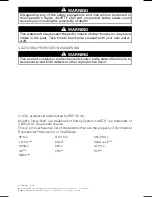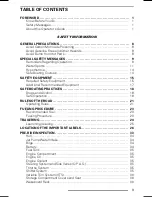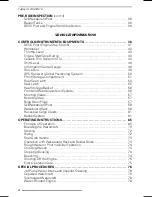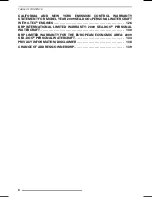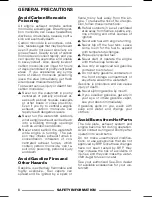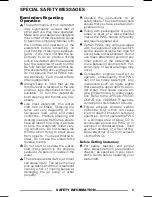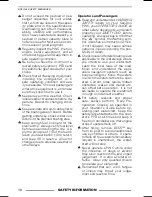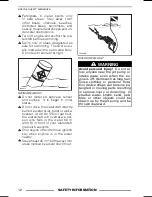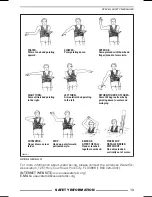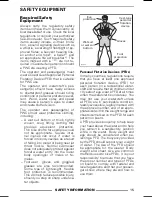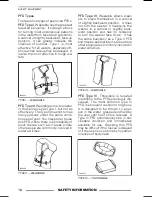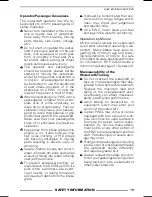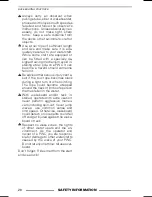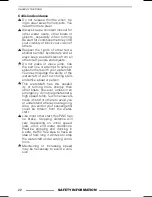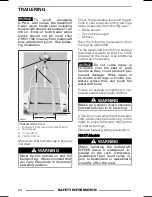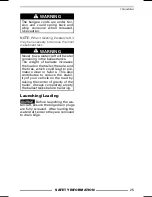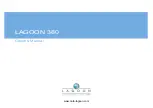
SPECIAL SAFETY MESSAGES
Do not exceed the payload or pas-
senger capacities for your water-
craft, which are listed on the capac-
ity plate and in the specifications.
Overloading can affect maneuver-
ability, stability and performance.
Also, heavy seas reduce capacity. A
payload or person capacity plate is
not an excuse for failure to use com-
mon sense or good judgment.
Regularly inspect the PWC, the hull,
engine, safety equipment, and all
other boating gear and keep them in
safe operating condition.
Be sure you have the minimum re-
quired safety equipment, PFDs and
any additional gear needed for your
cruise.
Check that all lifesaving equipment,
including fire extinguisher, is in
safe operating condition and eas-
ily accessible. Show all passengers
where this equipment is, and make
sure they know how to use it.
Keep an eye on the weather. Check
local weather broadcasts before de-
parture. Be alert to changing condi-
tions.
Keep accurate and up-to-date charts
of the boating area on board. Before
getting underway, check water con-
ditions in the planned boating area.
Keep enough fuel on board for the
planned trip. Always verify fuel level
before use and during the ride. Ap-
ply the principle of 1/3 of the fuel to
reach your destination, 1/3 to return,
and keep 1/3 in reserve. Allow for
changes due to adverse weather or
other delays.
Operators and Passengers
Read and understand all
WARNING/
SAFETY
labels on your Sea-Doo
PWC, your
OPERATOR’S GUIDE
, all
other safety documents, and watch
properly your
SAFETY DVD
, before
operating. Always keep in mind that
the “
“ symbol, the Warning sym-
bol, identifies an instruction which,
if not followed, may cause serious
personal injuries including the pos-
sibility of death.
Check local and federal boating laws
applicable to the waterways where
you intend to use your watercraft.
Learn the local rules of the road.
Know and understand the appli-
cable navigation system (such as
buoys and signs). Know the waters
in which the watercraft is to be oper-
ated. Current, tides, rapids, hidden
obstacles, wakes and waves etc.
can affect safe operation. It is not
advisable to operate the watercraft
in rough or inclement weather.
For safety reasons and proper
care, always perform “Daily Pre-
operation Checks” as specified in
your Operator’s Guide before op-
erating your watercraft. Keep the
safety lanyard attached to the oper-
ator’s PFD at all times and keep it
free from handlebars so that engine
stops if operator falls off.
After riding, remove DESS™ key
from its post to avoid unauthorized
use by children or others. If opera-
tor falls off the watercraft and safety
lanyard is unattached, the water-
craft will not stop
Never operate a PWC while under
the influence of drugs or alcohol
they slow reaction time and impair
judgement. It is also a Federal of-
fense. Allow only qualified drivers
to operate your watercraft.
Remember that sun, wind, fatigue
or illness may impair your judge-
ment and reaction time.
10
_______
SAFETY INFORMATION
________
Содержание 2009 Sea-Doo GTI Series
Страница 9: ...SAFETY INFORMATION ________ SAFETY INFORMATION ________ 7...
Страница 30: ...LOCATION OF THE IMPORTANT LABELS F16L0PL LABEL 1 TYPICAL RXP MODELS 28 _______ SAFETY INFORMATION ________...
Страница 39: ...VEHICLE INFORMATION _______________ 37...
Страница 83: ...MAINTENANCE INFORMATION _______________ 81...
Страница 100: ...STORAGE AND PRESEASON PREPARATION 98 ______________...
Страница 101: ...TECHNICAL INFORMATION _______________ 99...
Страница 114: ...SPECIFICATIONS 112 ______________...
Страница 115: ...TROUBLESHOOTING ______________ 113...
Страница 123: ...WARRANTY ______________ 121...
Страница 142: ...140 ______________...
Страница 144: ...142 ______________...
Страница 146: ...144 ______________...


